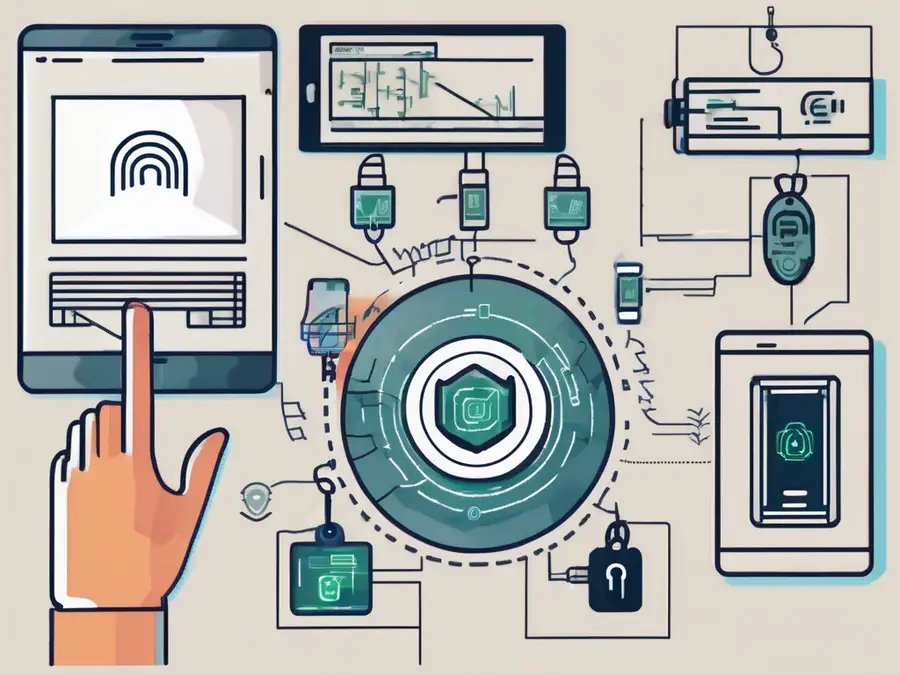Overview of Two-Factor Authentication Schemes

Hello, fellow internet users! Welcome to my comprehensive guide on the different types of two-factor authentication (2FA). In this article, I'll be taking you through the fascinating world of 2FA and unraveling its importance, evolution, and the various types available today. So, let's dive right in!
Understanding 2FA: An Overview
Before we delve into the specifics, let's start with the basics. What exactly is 2FA? Well, 2FA is an additional layer of security that adds an extra step to the traditional username and password login process. It requires users to provide two pieces of evidence to authenticate their identity. This robust authentication process significantly enhances security and mitigates the risk of unauthorized access to your accounts.
What is 2FA?
In simple terms, 2FA is a process that provides an additional layer of security beyond just a username and password. It typically combines something you know (e.g., your password) with something you have (e.g., a verification code sent to your phone). This combination makes it much harder for hackers to gain access to your accounts.
Importance of 2FA in Today's Digital Age
With the ever-increasing frequency of cyberattacks and data breaches, securing our online accounts has become more critical than ever. Passwords, no matter how strong, can be vulnerable to hacking techniques. This is where 2FA comes to the rescue. By employing 2FA, you add an extra layer of protection, making it significantly more challenging for attackers to breach your accounts.
Now that we've covered the fundamentals, let's explore the evolution of 2FA and understand how it has evolved over time.
As technology advances, so does the sophistication of cyber threats. To keep up with these evolving challenges, 2FA has also undergone significant transformations. Initially, 2FA primarily relied on SMS messages or email verification codes for the second factor. However, with the rise of more advanced hacking techniques such as SIM swapping and phishing attacks, these methods have shown vulnerabilities.
In response to these vulnerabilities, newer forms of 2FA have emerged, such as biometric authentication (using fingerprints or facial recognition) and hardware tokens (physical devices that generate one-time passcodes). These methods offer a higher level of security compared to traditional SMS codes, as they are more resistant to interception and spoofing attempts.
The Evolution of 2FA
The Birth of 2FA
2FA has come a long way since its inception. The concept of 2FA first emerged in the early 1970s when the password-based authentication system started showing its limitations. A simple username-password combination was no longer sufficient to safeguard against unauthorized access, leading to the birth of 2FA.
As technology advanced, the need for stronger security measures became increasingly apparent. This led to the development of two-factor authentication (2FA), a method that requires two forms of identification before granting access to a system or account. By combining something the user knows (like a password) with something they have (like a smartphone or token), 2FA significantly enhances security and reduces the risk of unauthorized access.
The Progression of 2FA Technologies
Over the years, the progression of technology has brought about various 2FA technologies. From hardware tokens to mobile apps and biometric verification, the possibilities seem endless.
Now, let's take a closer look at the different types of 2FA available today.
One of the most common forms of 2FA is SMS-based authentication, where a one-time code is sent to the user's mobile phone for verification. While convenient, this method has been criticized for its susceptibility to SIM swapping attacks and phishing scams. As a result, many companies are now moving towards more secure alternatives such as time-based one-time passwords (TOTP) generated by authenticator apps like Google Authenticator or Authy.
Different Types of 2FA
SMS-Based 2FA
SMS-based 2FA involves receiving a verification code via text message to your mobile device. This method is widely adopted due to its simplicity and ease of use. However, it is worth noting that SMS-based 2FA is susceptible to SIM card swapping attacks, making it less secure compared to other methods.
Email-Based 2FA
Email-based 2FA utilizes your registered email address to send a verification code. Upon entering the code, you gain access to your account. This method is convenient, but it highly depends on the security of your email account. If your email account gets compromised, an attacker can bypass this type of 2FA easily.
App-Based 2FA
App-based 2FA relies on specialized authenticator apps installed on your smartphone. These apps generate unique verification codes that change frequently, providing an extra layer of security. The most widely used app-based 2FA is Google Authenticator. It is secure, convenient, and does not require an internet connection.
Hardware-Based 2FA
Hardware-based 2FA involves the use of physical devices, often in the form of USB keys or smart cards. These devices store digital certificates and generate secure verification codes. This method is considered one of the most secure forms of 2FA, as it requires physical possession of the hardware token.
Adding an extra layer of security to your online accounts through two-factor authentication (2FA) has become increasingly important in today's digital landscape. By requiring users to provide two different authentication factors, 2FA significantly enhances the security of your accounts and helps prevent unauthorized access.Each type of 2FA has its own strengths and weaknesses, making it crucial for users to choose the method that best suits their needs and security concerns. While SMS-based 2FA is easy to set up, it is vulnerable to interception attacks. On the other hand, app-based 2FA offers a more secure solution by generating time-sensitive codes that are not easily replicated.Furthermore, hardware-based 2FA provides an additional level of protection by requiring a physical token for authentication. This method is particularly favored by individuals and organizations handling sensitive information or high-security data. It ensures that even if a password is compromised, unauthorized access is still prevented without the physical token.
The Pros and Cons of Different 2FA Types
Assessing SMS-Based 2FA
Pros: Easy to set up and widely supported.Cons: Prone to SIM card swapping attacks, making it less secure.
Evaluating Email-Based 2FA
Pros: Convenient and widely available.Cons: Vulnerable if the email account gets breached.
Analyzing App-Based 2FA
Pros: Secure and convenient, does not require an internet connection.Cons: Relies on smartphone usage and app compatibility.
Weighing Hardware-Based 2FA
Pros: High level of security, requires physical possession of the token.Cons: Possibility of losing the hardware device and reliance on compatible systems.
As you can see, each type of 2FA has its own advantages and disadvantages. It's crucial to choose the method that suits your needs and provides the level of security you desire.
Expert's Advice: Protect your Digital Identity
As an expert in cybersecurity, I cannot emphasize enough the importance of adopting 2FA. It is a powerful tool that significantly strengthens your online security. My personal advice is to enable app-based 2FA whenever possible. It strikes a balance between convenience and security, providing solid protection without compromising usability.
One personal anecdote that highlights the value of 2FA is when a colleague of mine fell victim to a phishing attack. Fortunately, they had 2FA enabled on their account, which prevented the attacker from gaining access. This incident reinforced the importance of 2FA in safeguarding our digital identities.
Frequently Asked Questions (FAQ)
What is 2FA?
2FA, or two-factor authentication, is an additional layer of security that requires users to provide two pieces of evidence to authenticate their identity. It adds an extra step to the traditional username and password login process.
Why is 2FA important?
In today's digital age, cyberattacks and data breaches are on the rise. 2FA significantly enhances security and mitigates the risk of unauthorized access to your accounts. It adds an extra layer of protection beyond just a password, making it much harder for hackers to gain access.
Which type of 2FA is the most secure?
Hardware-based 2FA is considered one of the most secure forms of 2FA. It requires physical possession of the hardware token, providing an additional layer of protection.
What is the best type of 2FA for general use?
App-based 2FA is widely considered the best type of 2FA for general use. It is secure, convenient, and does not require an internet connection. Google Authenticator is one popular app-based 2FA method.
Should I enable 2FA on all my accounts?
Yes! I strongly recommend enabling 2FA on all your accounts whenever possible. It adds an extra layer of protection and significantly reduces the risk of unauthorized access to your accounts.
I hope this comprehensive guide has shed light on the different types of 2FA and their significance in securing our digital lives. Remember, protecting your online accounts is not a luxury; it's a necessity. Stay safe, stay secure!
Now that you're equipped with the knowledge of securing your digital identity with 2FA, why not apply that to your trading endeavors? Morpher is the perfect platform to take your investments to the next level with its revolutionary blockchain technology. With no trading fees, infinite liquidity, and the ability to trade a vast array of assets, Morpher is transforming how we think about investing. Sign up today, enhance your trading experience, and as a bonus, get your free sign-up bonus to start your journey with Morpher. Don't just trade; trade smarter and safer with Morpher.

Disclaimer: All investments involve risk, and the past performance of a security, industry, sector, market, financial product, trading strategy, or individual’s trading does not guarantee future results or returns. Investors are fully responsible for any investment decisions they make. Such decisions should be based solely on an evaluation of their financial circumstances, investment objectives, risk tolerance, and liquidity needs. This post does not constitute investment advice.

Painless trading for everyone
Hundreds of markets all in one place - Apple, Bitcoin, Gold, Watches, NFTs, Sneakers and so much more.

Painless trading for everyone
Hundreds of markets all in one place - Apple, Bitcoin, Gold, Watches, NFTs, Sneakers and so much more.








